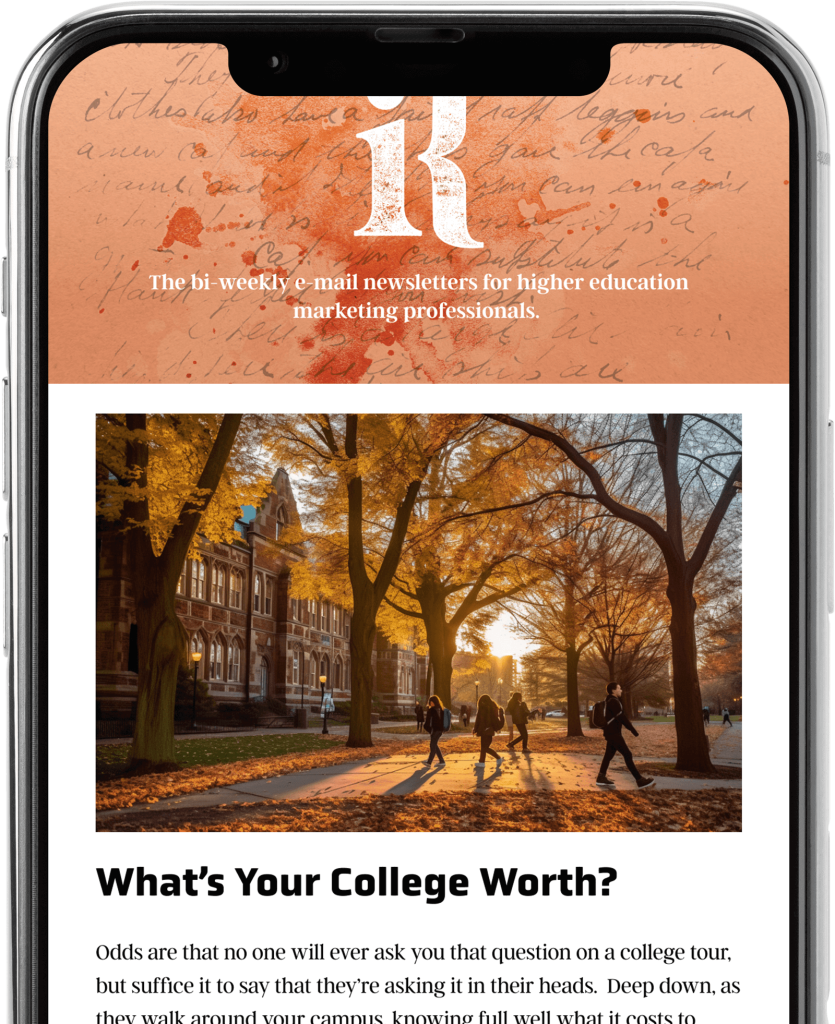HIGHER EDUCATION BRAND
The Power of Analogy in Higher Education Marketing

In our quest to help a “right fit” student understand who we are and why we might be right for their experience, it’s tempting to write a great deal of narrative filled with flowery language, platitudes, and ramblings about how great we are. But the challenge of this is that most of the schools that keep us up at night are doing the same thing and confusing the prospective student. All they end up hearing is that “we’re better,” which fits in perfectly with the chorus of other schools espousing the same thing. When we do this, we become part of the problem instead of exploiting the opportunity to resonate truly and deeply while separating ourselves in the process.
Former Apple employee Tony Fadell, largely credited with leading the creation of the iPod and iPhone (before later launching his own venture to create the Nest Learning Thermostat) in close partnership with cofounder and CEO Steve Jobs, offers an alternative way of helping customers understand a brand’s place. In his book Build: An Unorthodox Guide to Making Things Worth Making, Fadell shares many lessons and stories around the ups and downs of innovation and helping customers understand how to relate to or think about a product. Among those is the simple yet powerful device of an analogy.
When trying to determine how to help customers comprehend the iPod’s capacity to store the equivalent of 100 compact discs within a handheld device (where competing device might only store 2 or 3 CDs), Jobs employed the use of analogy to propel the offering forward: ‘it’s like having 1,000 songs in your pocket.’
“[Jobs would] …always say that analogies give customers superpowers. A great analogy allows a customer to instantly grasp a difficult feature and then describe the feature to others…Everyone had CDs and tapes in bulky players that only let you listen to 10-15 songs, one album at a time. So ‘1,000 songs in your pocket’ was an incredible contrast…it let people visualize this intangible thing…and gave them a way to tell their friends and family why this new iPod thing was so cool.”1
It took Apple nearly a year to arrive at the right analogy to help launch the product so it’s important to stay patient if your institution’s analogy—assuming this device is right for you—doesn’t arrive immediately. Ideally it should be tightly in sync with your institution’s Brand Vision, Position, and otherwise so that all of these devices support—not conflict with—one another.
To begin thinking about an analogy that might work for your institution, consider that the power very much lies in making the unfamiliar (who you are) familiar to the prospective student. To help bridge that divide, the analogy we use must be familiar to the audience. You might consider using familiar brands, people, landmarks, or places to get there.
Bear in mind that some master analogy to encapsulate the entire institution (e.g. we think of ourselves as the Tesla of small schools) may not be appropriate. Perhaps instead, look for aspects of your institution to explain through the use of analogy in ways that help prospective students understand your unique offerings or position. Examples include:
- Our career services department is kind of like having an on-campus LinkedIn platform: powerful technology, a concentration of highly networked professionals, and a real-time focus to connections and communication.
- Our campus is like a garden where students are nurtured and encouraged to grow. Different academic disciplines represent unique plants, and the supportive environment acts as a fertile soil for personal and academic development.
- Our student activities office is like a Starbucks experience: a vibrant atmosphere, a hive of activity, and an almost unlimited number of curated choices.
- A helpful exercise is to imagine a student ambassador sharing these analogies with prospective students and their parents during a campus tour. What analogies would be helpful to characterize your institution and what would catch the attention of your visitors, helping them remember more about you along the way?
1 Tony Fadell, Build: An Unorthodox Guide to Making Things Worth Making, p 112, Harper Business, 2022
Like what you're reading?
Subscribe to our newsletter to get the latest insights in Higher Education and thought leadership.


